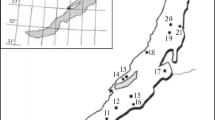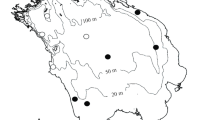Abstract
Using two different surface microlayer sampling devices (the Harvey and Burzell glass plate and the Garrett screen), two microlayer fractions could be distinguished. The first was from 0 to 50 µm and the second was from 51 to 320 µm. Significantly different (p < 0.05) concentrations of dissolved nutrients between the two microlayer fractions strongly suggests stratification within the surface microlayer. This apparent stratification is also examined for phototrophs, bacteria and other material found within the surface microlayer.
Similar content being viewed by others
References
American Public Health Association., 1976. Standard methods for the examination of water and wastewater. 14th ed. Washington, D.C. 974 pp.
Danos, S. C., 1980. The seasonal variation and enrichment of nutrients and chlorophyll in the surface microlayer of two small Wisconsin ponds. M.S. Thesis, University of Wisconsin - Milwaukee. 201 pp.
Daumas, R. A., Laborde, P. L., Marty, J. C. & Sailot, A., 1976. Influence of sampling methods on the chemical composition of water surface film. Limnol. Oceanogr. 21: 319–326.
DiSalvo, L. H., 1973. Contamination of surfaces by bacterial neuston. Limnol. Oceanogr. 18: 165–168.
Fehon, W. C. & Oliver, J. D., 1979. Taxonomy and distribution of surface microlayer bacteria from two estuarine sites. Estuaries 2: 194–197.
Gallagher, J. L., 1975. The significance of the surface film in salt marsh plankton metabolism. Limnol. Oceanogr. 20: 120–123.
Garrett, W. D., 1965. Collection of slick-forming materials from the sea surface. Limnol. Oceanogr. 10: 602–605.
Garrett, W. D., 1967. The organic chemical composition of the ocean surface. Deep-Sea Res. 14: 221–227.
Gibson, V. R., 1971. Vertical distribution of estuarine phytoplankton in the surface microlayer and at one meter, and fluctuations in abundance caused by surface adsorption of monomolecular films. M.S. Thesis, University of Virginia. 47 pp.
Goering, J. J. & Wallen, D., 1967. The vertical distribution of phosphate and nitrite in the upper one-half meter of the Southeastern Pacific Ocean. Deep-Sea Res. 14: 29–33.
Hamilton, R. D., 1964. Photochemical processes in the inorganic nitrogen cycle of the sea. Limnol. Oceanogr. 9: 107–111.
Hardy, J. T., 1973. Phytoneuston ecology of a temperate marine lagoon. Limnol. Oceanogr. 18: 525–533.
Harvey, G. W. & Burzell, L. A., 1972. A simple microlayer method for small samples. Limnol. Oceanogr. 17: 156–157.
Harvey, R. W. & Young, L. Y., 1980a. Enrichment and association of bacteria and particulates in salt marsh surface water. Appl. envir. Microbiol. 39: 894–899.
Harvey, R. W. & Young, L. Y., 1980b. Enumeration of particle-bound and unattached respiring bacteria in the salt marsh environment. Appl. envir. Microbiol. 40: 156–160.
Hatcher, R. F. & Parker, B. C., 1974a. Investigations of freshwater surface microlayers. Virginia Polytechnic Institute and State University, Water Resources Research Center, 64. 84 pp.
Hatcher, R. F. & Parker, B. C., 1974b. Microbiological and chemical enrichment of freshwater-surface microlayers relative to the bulksubsurface water. Can. J. Microbiol. 20: 1051–1057.
Hobbie, J. E., Daley, R. J. & Jasper, S., 1977. Use of Nuclepore filters for counting bacteria by fluorescence microscopy. Appl. envir. Microbiol. 33: 1225–1228.
Jarvis, N. L., Garrett, W. D., Scheinman, M. A. & Timmons, C. O., 1967. Surface chemical characterization of surface-active material in seawater. Limnol. Oceanogr. 12: 88–96.
Larsson, K., Odham, G. & Södergren, A., 1974. On lipid surface films on the sea. I. A simple method for sampling and studies of composition. Mar. Chem. 2: 49–57.
Maki, J. S. & Remsen, C. C., 1981. Comparison of two direct-count methods for determinting metabolizing bacteria in freshwater. Appl. envir. Microbiol. 41: 1132–1138.
Manzi, J. J., Stofan, P. E. & Dupuy, J. L., 1977. Spatial heterogeneity of phytoplankton populations in estuarine surface microlayers. Mar. Biol. 41: 29–38.
Nishizawa, S., 1971. Concentration of organic and inorganic materials in the surface skin at the equator, 155°W. Bull. Plank. Soc. Japan 18: 42–44.
Norkrans, B., 1979. Role of surface microlayers. In: Bourquin, A. W. & Pritchard, P. H. (Eds.) Microbial Degradation of Pollutants in Marine Environments. U.S. Environmental Protection Agency. Gulf Breeze, FL. EPA-600/9–79–012, pp. 201–213.
Norkrans, B., 1980. Surface microlayes in aquatic environments. Adv. Microbial Ecol. 4: 51–85.
Olson, R. J., 1981a. 15N tracer studies of the primary nitrite maximum. J. mar. Res. 39: 203–226.
Olson, R. J., 1981b. Differential photoinhibition of marine nitrifying bacteria: a possible mechanism for the formation of the primary nitrite maximum. J. mar. Res. 39: 227–238.
Parker, B. C. & Hatcher, R. F., 1974. Enrichment of surface freshwater microlayers with algae. J. Phycol. 10: 185–189.
Piotrowicz, S. R., Ray, B. J., Hoffman, G. L. & Duce, R. A., 1972. Trace metal enrichment in the sea-surface microlayer. J. geophys. Res. 77: 5243–5254.
Riley, G. A., Van Hemert, D. & Wangersky, P. J., 1965. Organic aggregates in surface and deep waters of the Sargasso Sea. Limnol. Oceanogr. 10: 354–363.
Sieburth, J. McN., 1965. Bacteriological samplers for air-water and water-sediment interface. Ocean Sci. Ocean Eng., Trans. Jt. Conf. Mar. Tech. Soc. and ASLO, Washington, D.C.: 1064–1068.
Sieburth, J. McN., 1971. Distribution and activity of oceanic bacteria. Deep-Sea Res. 18: 1111–1121.
Sieburth, J. McN., Willis, P. J., Johnson, K. M., Burney, C. M., Lavoie, D. M., Hinga, K. R., Carson, D. A., French, F. W., Johhson, P. W. & Davis, P. G., 1976. Dissolved organic matter and heterotrophic microneuston in the surface microlayer of the North Atlantic. Science 194: 1415–1418.
Strickland, J. & Parsons, T. R., 1972. A practical handbook of seawater analysis. Fish. Res. Bd. Can. Bull. 167.
Technicon., 1973. Industrial methods. Technicon Instruments Corp., Tarrytown, New York. Loose leaf, n.p.
Tsyban, A. V., 1971. Marine bacterioneuston. J. Ocean. Soc. Japan 27: 56–66.
Williams, P. M., 1967. Sea surface chemistry: organic carbon and organic and inorganic nitrogen and phosporus in surface films and subsurface waters. Deep-Sea Res. 14: 791–800.
Author information
Authors and Affiliations
Additional information
Based in part on an M.S. thesis, submitted to the Graduate School of University of Wisconsin - Milwaukee.
Rights and permissions
About this article
Cite this article
Danos, S.C., Maki, J.S. & Remsen, C.C. Stratification of microorganisms and nutrients in the surface microlayer of small freshwater ponds. Hydrobiologia 98, 193–202 (1983). https://doi.org/10.1007/BF00021021
Received:
Revised:
Accepted:
Issue Date:
DOI: https://doi.org/10.1007/BF00021021




